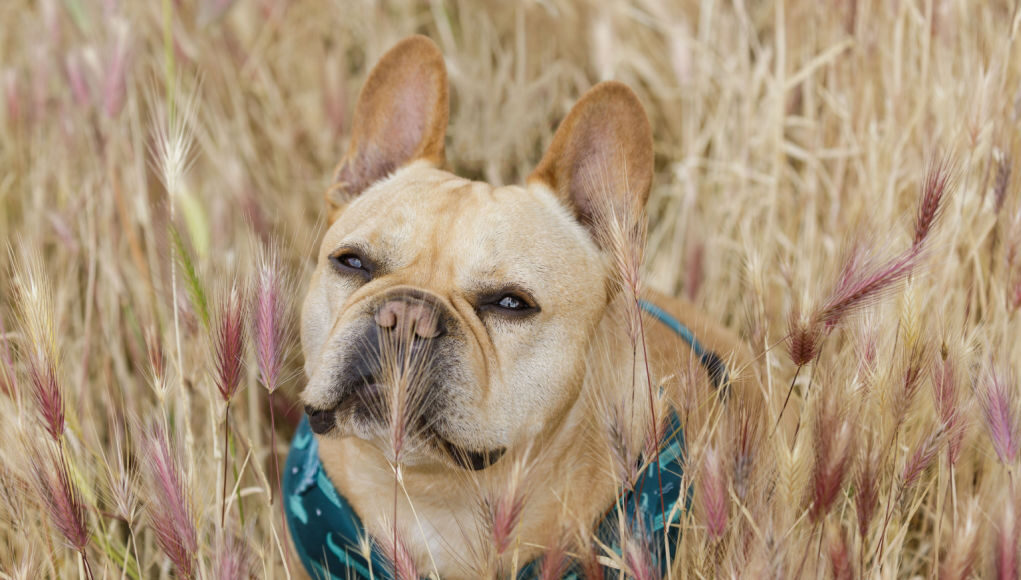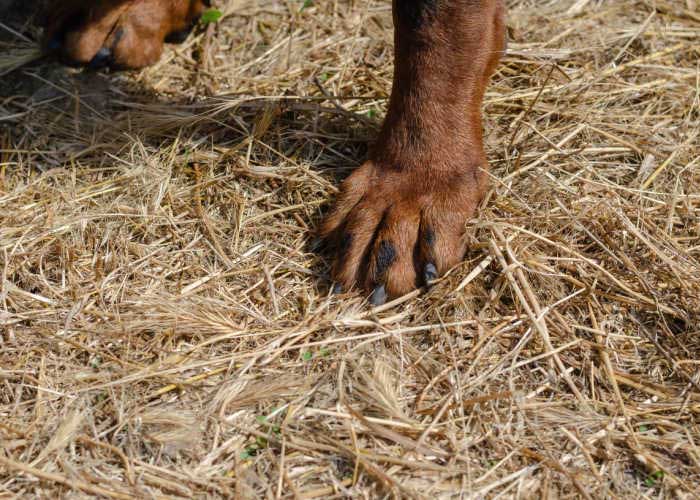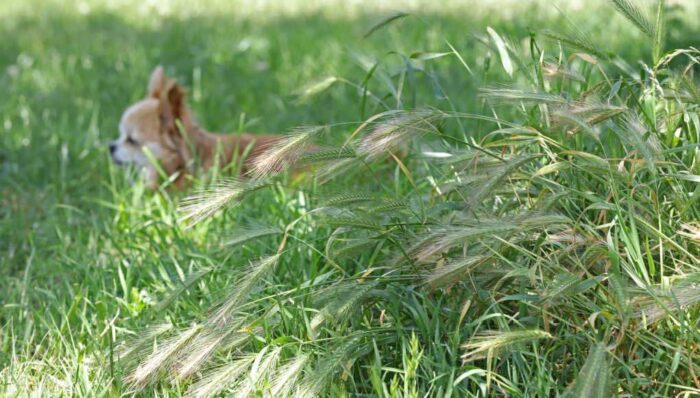Table of Contents
- What is a Foxtail?
- What Do Foxtails Look Like?
- Where Do Foxtails Grow in the United States?
- Why are Foxtails Dangerous for Dogs?
- Checking Your Dog for Foxtails
- Removing Foxtails from your Dog
- Preventing Foxtails from Harming Your Dog
- Controlling Foxtails in Hayfields and Pastures
- Destroying Foxtail Fields
- FAQs about Foxtails and Dogs
- Foxtails and Dogs: Final Thoughts
The sun is shining. The temperature is rising.
Sounds like summertime to me! And what better way to enjoy the warm weather than by exploring the great outdoors with our canine companions?
From camping to hiking, summer can be a terrific time to bond with your pet.
But flourishing in this season are the foxtail plants that can get caught on your pup’s coat while he’s having fun in the sun.
The seeds from these weeds burrow into his skin, which may cause discomfort, infection, and sometimes more severe problems.
This means that aside from greater exposure to ticks and other insects in the summer, things can go wrong for your pooch as you hit the open trails and you find yourselves in a foxtail field.
So, before you go on your adventures, read up on the dangers of foxtails and how to prevent them from hurting your pooch.
What is a Foxtail?
Foxtails are an annual summer grass that is also known by the names grass seed awns, mean seeds, timothy, cheatgrass, June grass, Downy brome, and other local names.
They begin to grow in the spring and reach their full bloom in the summer. Then, they will die naturally in the winter.
At the tip of this grass-like weed, the seeds are arranged in spikey clusters with barbs facing backward, resembling a fox's tail.
This plant is particularly designed by nature to scatter its seeds, posing a serious threat to animals passing by as they burrow deeper into objects with each movement.
Not only do they dig themselves into the skin, but they also work their way in through the ears, eyes, nose, and mouth.
What Do Foxtails Look Like?
There are six different foxtail species, although only three of them are widespread, appearing in every county.
They are all annual, non-native grasses that produce spikelets in the summer.
The grasses you are most likely to run into are Giant (Setaria faberi), Yellow (Setaria pumila or Setaria glauca), and Green Foxtail (Setaria viridis).
But how can you differentiate one from another?
Now, these grasses share many structural characteristics as well as a distinctive brush-like seed head that looks like a fox's tail.
In lawns, gardens, farms, and orchards, foxtails often cause significant weed problems.
Because they produce numerous seeds, they spread quickly. Examine the stems, blades, and seed heads of foxtail grasses to determine their identity and recognize them from other types of grass.
Size
Green and yellow foxtail grasses can reach heights of one to three feet, whereas giant foxtails can reach heights of three to seven feet. They usually grow in clumps.
Habitat
Foxtails prefer disturbed regions with bare soil, such as croplands, gravelly areas by roadways, and cracks in sidewalks and parking lots.
Although they may thrive in poor soil, foxtails prefer the fertile ground.
While big foxtail is more common in the southeast, yellow and green foxtails can be found throughout the country.
Ligules
The collar region is the intersection of the sheath and the grass blade, which surrounds the stems of grasses.
A little membranous outgrowth at the junction known as a ligule distinguishes and defines grasses.
To see the ligule clearly, slightly pull back the grass blade.
Foxtail grasses have a distinctive fringe of small, thick hairs on their ligule.
Grass Blades
Green and yellow foxtails have flat blades that are between 1/4 and 1/2 inches wide. Giant foxtail has blades that are half an inch or bigger.
While green foxtail has smooth blade surface, both yellow and huge foxtails have hairs on the upper surfaces of their blades.
Seedheads
Foxtails have tiny flower heads that grow into seed heads that are affixed to bristles.
Seedheads on yellow foxtails can reach 3 inches and have short, rough bristles.
Giant foxtails have seedheads that are between three and seven inches tall and tend to droop, whereas green foxtails have soft, nodding seedheads up to six inches long.
Compared to yellow foxtails, the bristles of green and giant foxtails are longer.
The foxtail blooms are pollinated by the wind, and when the seeds mature, they fall to the ground and are dispersed to new locations by wildlife.
Where Do Foxtails Grow in the United States?
Foxtails can be found almost everywhere in North America and can exist year-round in western states like California.
In fact, all states in the U.S. are said to have foxtails, except Florida, Georgia, Hawaii, Louisiana, North Carolina, South Carolina, and Virginia.
These plants are often found in hiking trails, meadows, parks, and wide fields of grass.
Though less common in cities, you can still find them in areas where the grass is allowed to grow unchecked.
The foxtail dries out in warm weather and hitches a ride on anything moving, which is important for the spread of its seed.
Why are Foxtails Dangerous for Dogs?
By penetrating through the skin or traveling through the nose, ears, and eyes, foxtails find their way inside your dog’s body.
Once inside, they continue to move forward, bringing bacteria and dirt along with them.
Since internal organs may be impacted, this can result in much more severe conditions.
To locate and get rid of the foxtail, it may be necessary to use advanced diagnostic procedures.
Until then, it will continue to cause trouble that is beyond simple irritation.
An embedded foxtail can cause serious infection because the seeds don't degrade inside the body. And if left untreated, it can lead to death.
Checking Your Dog for Foxtails
Embedded foxtails can cause inflammation and pain.
If your dog is showing any of the following signs and symptoms, take him to your vet as soon as possible.
- Ears – scratching ceaselessly at an ear, head shaking, and head tilting
- Eyes – pawing at an eye that is red, swollen, or has excessive tearing or discharge
- Nose – persistent sneezing and bloody nose
- Paws – swelling between the toes and limping
- Continuous licking of the affected area
If there’s a bacterial infection, your pup will show poor appetite, restlessness, bumps, and lumps.
In some cases, they can reach vital organs like the brain, spinal cord, lungs, or heart and cause symptoms specific to that organ.
Surgery may be necessary to remove the foxtails or to treat an infection brought on by the embedded foxtails.
Removing Foxtails from your Dog
If you live in a region where foxtails are common, always check your dog after letting him out.
It's important to remove the foxtail as early as possible. So, if you spot one on your dog’s fur or skin, you can try to remove it with tweezers.
However, there is a risk of leaving bits of the foxtail if you do it on your own.
Ready to dig deeper, they will spread widely through body cavities, hence, the entire foxtail needs to be removed.
So, if it is deeply embedded in the skin, leave it to the experts. And if there are any indications that a foxtail has penetrated the skin or entered an opening in his body, then you’ll have to bring your poor dog to the vet immediately.
Preventing Foxtails from Harming Your Dog
Any dog, especially those breeds for hunting, can come in contact with foxtails when wandering through a grass field because they are quite widespread throughout America.
However, there are a few ways you can keep your furry friend safe.
- Long-coated dogs are more likely to pick up these hitchhikers. Consider trimming your pooch during the foxtail season.
- You may opt for vests that will cover and protect your dog’s chest and abdomen if he spends a lot of time outside.
- Stay away from foxtail-prone areas.
- Use a short leash when taking your dog for a stroll.
- If you notice foxtails and other tall grasses growing in your yard, either plan to remove them or hire a landscaper to help.
- Check for foxtails when you’re out hiking or hunting. Consider wrapping his paws with dog booties if there’s a chance you won’t be able to avoid areas where foxtails grow.
RELATED: 5 Best Service Dog Vests and Harnesses for Working Dogs
Controlling Foxtails in Hayfields and Pastures
Foxtail is a troublesome grass that grows in hayfields and pastures, and infestations require rapid care.
While minor foxtail infestations merely require spot treatment, larger infestations need entire pasture redevelopment.
To eliminate any foxtail plants that may already be present, herbicide application is advised. Non-herbicide alternatives include repeat tillage and summertime rest.
Since foxtail seeds are already present in the soil, those must also be removed.
Lastly, the foxtail needs to be removed and replaced with a robust patch of grass and clover that can compete with it.
A recommended treatment plan for foxtail consists of soil analysis, fertilization, use of herbicides, preparation of the site, reseeding with a desirable species, adequate grazing management, and success monitoring.
Destroying Foxtail Fields
As a grass, foxtail cannot be controlled by broadleaf herbicides.
An herbicide called glyphosate, which is non-selective, will destroy foxtail as well as the majority of other plants (grasses and broad-leaved).
The relatively recent herbicide propoxycarbazone-sodium (marketed under the brand name Lambient) is selective against several broadleaf weeds and weedy grasses, including foxtail, and won't harm the majority of enhanced forage grasses.
If foxtail is present in large quantities, use glyphosate to completely eradicate it.
When desirable grasses dominate and foxtail is only a minor component, use Lambient for a more selective kill.
Temporary Pasture Forage
To destroy the majority of foxtail plants that emerge from the soil's existing seed bank, glyphosate will likely need to be used twice or three times.
As a result, a series of yearly crop plantings are needed for a temporary pasture.
The foxtail seed bank will be exhausted if it isn't permitted to go to seed once again.
Due to the foxtail's ability to produce another seed head on a shorter stalk, mowing has proven futile.
Even while foxtail is usually considered an annual plant, it has exhibited perennial characteristics, especially when cultivated under irrigation systems.
Permanent Pasture Forage
Plant a permanent pasture following the last glyphosate treatment after utilizing the complete kill technique and being certain that the foxtail problem is under control.
After the final round of treatment, sow new seeds of ideal forage without reworking the soil.
Make sure the forage plants you choose are suitable for your pasture location (drainage, intended use, irrigation, etc.), and that you've taken steps to solve any difficulties with soil fertility.
Once your new pasture has established itself, good grazing management is necessary to keep it healthy.
FAQs about Foxtails and Dogs
Can a dog survive with a foxtail?
These weeds are designed to burrow into the ground.
If they attach to your pet’s coat and burrow into the skin, this can lead to pain, infection, and even death when left untreated.
How do you know if your dog has a foxtail?
If your dog is persistently licking an area and you observe swelling, he may have a foxtail on his body.
It may be embedded deeply into the skin or may be hidden so far inside that you can’t see it when a foxtail gets in through the ears.
What happens if a dog gets foxtail?
Foxtails in the mouth and throat will result in coughing, gagging, salivation, and sometimes compulsive grass chewing.
Get prompt medical help if your pet extends his neck to swallow.
Foxtails and Dogs: Final Thoughts
While it's best to stay away from overgrown, grassy areas, you can’t be certain that you can always steer clear of foxtail-growing places, especially during outdoor plays and adventure.
Learn about the risks associated with this plant, take extra precautions, and get rid of foxtails right away.
But despite your best efforts, foxtails can be sneaky and stubborn. Even the most attentive owner can overlook a foxtail injury.
Fortunately, foxtails that are fatally serious are pretty uncommon.
Early intervention is crucial, though. Therefore, whenever your dog is limping or has a wound that won't heal, seek veterinary care as soon as possible.


















